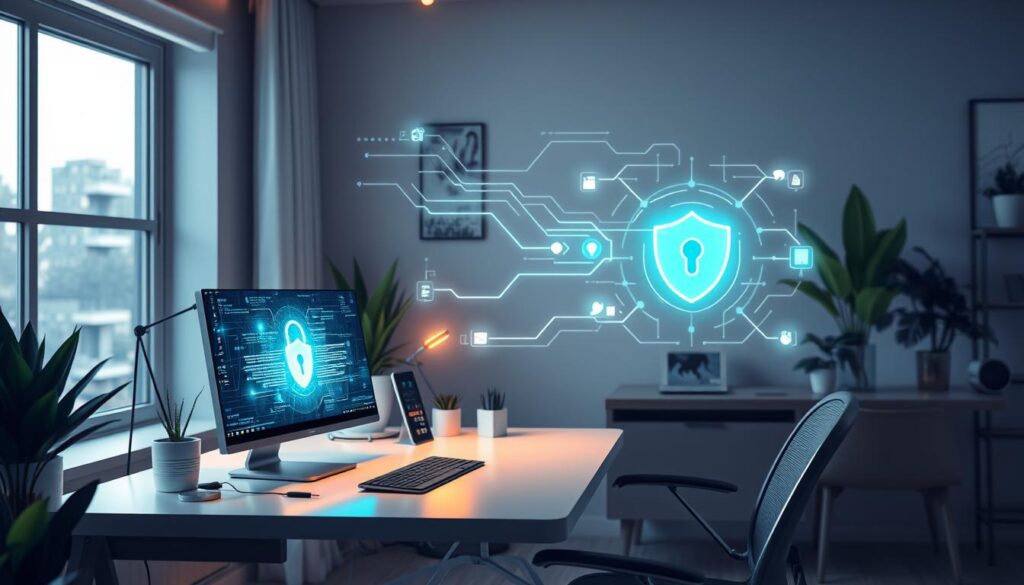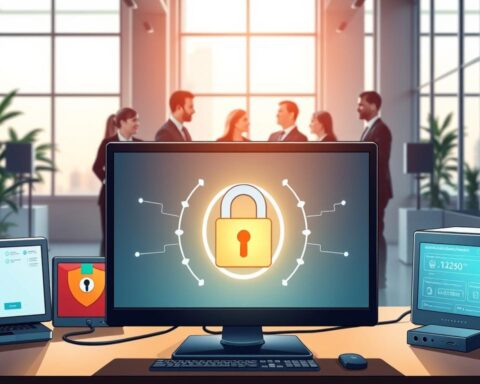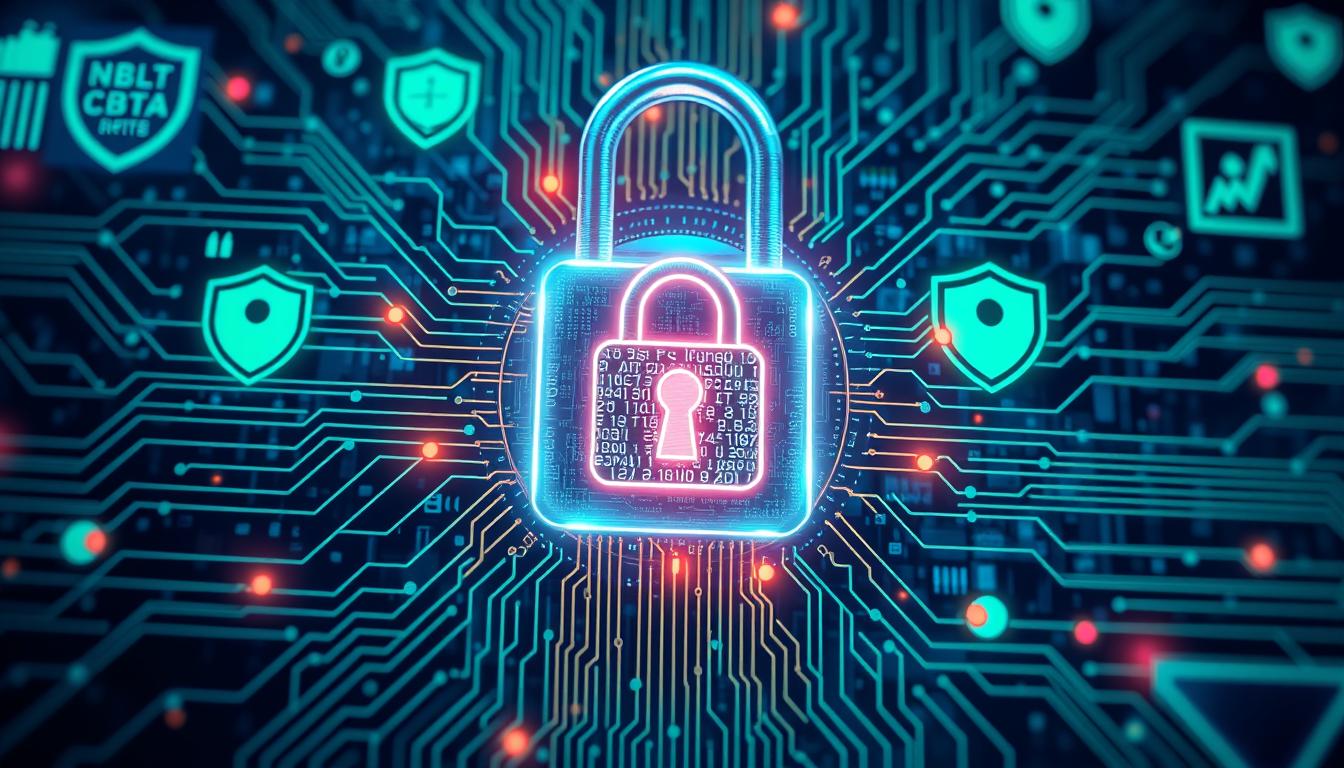Now, 40% of U.S. job seekers want fully remote jobs, and 33% prefer hybrid roles. This big change is making cybersecurity in remote and hybrid work more important1. It’s all about keeping workforces safe in these new settings.
The COVID-19 pandemic made remote work a must. Now, 63% of fast-growing companies need to keep their teams safe online1. This means they must focus on cybersecurity more than ever.
In our Day 19 Cybersecurity Training, we’ll tackle the big challenges of remote and hybrid work. We’ll talk about how to protect your team from online threats. You’ll learn about new security tools and strategies to keep your work safe.
Key Takeaways
- Remote and hybrid work models are now predominant in high-growth companies
- VPN vulnerabilities have increased significantly, posing new security risks
- Employee engagement is key for good cybersecurity programs
- Gamification makes cybersecurity training better
- Keeping security up to date is vital in today’s threats
- Multifactor authentication is a must-have security tool
Evolution of Remote Work Security Challenges
The way we work has changed a lot, with more people working from home or in hybrid setups. This change has made cybersecurity a top concern for businesses. IT teams face new challenges as corporate networks become more vulnerable.
Impact of COVID-19 on Workplace Transformation
The COVID-19 pandemic changed how we work fast. Companies had to quickly update their security to support remote work. In early 2020, cybercriminals took advantage of these changes. INTERPOL reported a huge number of malicious URLs, spam messages, and malware incidents linked to COVID-19 between January and April 20202.
Current State of Remote and Hybrid Work Models
Now, remote and hybrid work is common in companies. About 65% of workers prefer working from home3. This shift means more use of cloud computing, which brings new security risks3. Companies are using zero-trust security models and multi-factor authentication to tackle these issues.
Statistical Overview of Remote Work Adoption
Remote work has changed how we handle cybersecurity:
- Using unique, strong passwords is now key2.
- Two-factor or multi-factor authentication is used more to keep accounts safe23.
- AI and machine learning are used in endpoint detection and response systems to fight security threats on remote devices3.
| Security Measure | Adoption Rate | Impact |
|---|---|---|
| Multi-Factor Authentication | High | Significant reduction in unauthorized access |
| Zero-Trust Model | Growing | Enhanced protection against phishing attacks |
| EDR Systems | Increasing | Improved threat detection and response |
As remote work keeps evolving, so must our cybersecurity strategies. Companies must stay alert and adapt to protect against new threats in this changing work world.
Understanding the Expanded Attack Surface
The move to remote and hybrid work has changed the cybersecurity scene. Now, companies face more threats than before. They need a strong plan to keep their systems safe.
Home networks and personal devices are now targets for hackers. Many families share computers, making it easier for malware to spread4. Unsecured Wi-Fi networks also increase the risk of attacks like malware, phishing, and ransomware5.
Cloud services and VPNs are more popular than ever. But, they also bring new risks. The risk of cybercrime in the cloud has grown by 60 times4. VPNs are key for safe remote work, but they must be kept up to date.
How employees act is also a big factor. A scary 75% of workers reuse passwords, making it easier for hackers to get in5. This shows the need for better password management and security training.
| Vulnerability | Risk Level | Mitigation Strategy |
|---|---|---|
| Unsecured Home Networks | High | Implement VPNs and network security training |
| Shared Personal Devices | Medium | Enforce device management policies |
| Cloud Service Vulnerabilities | High | Regular security audits and updates |
| Password Reuse | High | Implement password managers and MFA |
To fight these threats, companies are using new security tools. Multi-factor authentication (MFA) is very effective, stopping 99.9% of automated attacks5. They also use Single Sign-On (SSO) systems and train employees to avoid phishing scams4.
As threats grow, so does the need for new cybersecurity strategies. Companies must find ways to protect their digital world and stay safe in the age of remote work.
Cybersecurity in Remote and Hybrid Work Environments
The move to remote and hybrid work has changed how we protect our digital world. Companies now face new challenges in keeping their data safe. A big 66% of security leaders say remote work has made them more vulnerable to cyber threats. Also, 58% have seen more cyber incidents after starting remote work6.
Core Security Principles
In today’s changing work scene, sticking to key security rules is key. Companies need to:
- Use strong access controls
- Encrypt important data
- Keep systems updated and patched
- Offer regular security training
Training is very important, as 34% of remote workers say their companies didn’t teach them enough about security. Teaching employees about cybersecurity can cut the risk of a breach by 70%6.
Risk Assessment Framework
A good risk assessment framework is vital for spotting and fixing threats in remote and hybrid work. It should cover:
- Device security
- Network weaknesses
- How to protect data
- How employees behave and follow rules
With 50% of workers using personal devices for work, companies must tackle the extra risks6. Also, 83% of workers want to work from home at least once a week after the pandemic, showing the need for lasting risk plans7.
Compliance Requirements
Remote work makes following rules harder. Companies need to update their compliance plans to handle these new issues:
| Compliance Area | Key Considerations |
|---|---|
| Data Privacy | Make sure data is safe everywhere |
| Access Control | Use strict login checks |
| Incident Response | Have plans for handling remote incidents |
| Auditing | Set up ways to check on remote work |
It’s clear that keeping up with rules is tough, with 80% of companies changing their cybersecurity rules for remote work6. This shows we need a flexible approach to cybersecurity in remote and hybrid work.
Critical Infrastructure Protection for Remote Workers
In today’s digital world, keeping remote work areas safe is key. With 35% of workers at home full-time and 41% on mixed schedules, companies face new security hurdles8. Let’s look at important ways to protect remote workspaces.
Secure Network Architecture
Creating a strong network is vital for safe remote access. Companies should use VPNs and firewalls to protect data. This method helps fight risks from public Wi-Fi, which 70% of remote workers use for work9.

Data Protection Strategies
Keeping data safe is essential, as a data breach can cost over $4 million9. Use end-to-end encryption for all sensitive data and have strict data handling rules. Also, make sure to back up data regularly, as 60% of companies that lose data go out of business within six months9.
Access Control Mechanisms
Strong access control is vital for remote work security. Use multi-factor authentication (MFA) to lower the risk of unauthorized access. MFA can block up to 99.9% of hacking attempts, making it a must-have for security9.
Human mistakes cause 90% of data breaches9. Focus on training employees to improve your security. By using these methods, you can build a strong, safe remote work environment.
Common Security Threats in Distributed Workforces
The rise of remote work has changed the cybersecurity world a lot. Now, 42% of employees work outside the office at least once a week. This means companies face more threats than before10.
Phishing attacks are a big worry, making up nearly 80% of security breaches in 202310. With more email use, it’s become a prime target for hackers11. Remote workers often fall for these scams, putting company data at risk.
Using weak passwords is another big problem. Employees often use the same password 13 times, making it easy for hackers to get in11. Many remote workers also use unsecured Wi-Fi, which can let hackers see sensitive info10.
Not updating software and using old systems is risky too. Remote workers often forget to update their software, leaving it open to attacks10. Hackers quickly find and use these weaknesses.
| Threat | Percentage | Impact |
|---|---|---|
| Phishing Attacks | 80% | Data Breaches |
| Human Error | 80%+ | Data Breaches |
| Weak Passwords | 13x reuse | Unauthorized Access |
Human mistakes are a big part of cybersecurity problems. Over 80% of data breaches in 2022 were caused by people’s errors11. Good remote work policies and training can help a lot. They can make companies safer and more secure.
Essential Security Technologies for Remote Work
Remote work comes with its own set of security challenges. To keep data and systems safe, companies need strong technologies. Let’s look at the key tools that are vital for remote work security.
Virtual Private Networks (VPNs)
VPNs create secure paths for remote access. They encrypt data, hiding IP addresses and keeping sensitive info safe. With 82% of leaders planning for remote work, VPNs are key12. But, they’re not enough on their own. Solutions like Zero Trust Network Access (ZTNA) offer more detailed control.
Multi-Factor Authentication Systems
Multi-factor authentication adds an extra layer of security beyond passwords. It’s essential in today’s world. MFA can greatly lower the risk of unauthorized access. It’s vital, given that 45% of companies faced cyber threats due to remote work during the pandemic12.
Endpoint Protection Solutions
Endpoint protection is critical, as 50% of office workers use personal devices for work13. These solutions include antivirus software, EDR tools, and MDM systems. They fight malware, spot suspicious activities, and manage device security policies.
Companies should invest in cybersecurity tools that fit the hybrid model, including endpoint protection and real-time threat detection systems12. Regular security checks and employee training are also key. Experts suggest doing security audits every six months and training every three months12.
By using these essential technologies and practices, companies can boost their cybersecurity in the changing work landscape. This protects against threats and ensures business can keep running in remote and hybrid settings.
Employee Security Training and Awareness
In today’s world, where many work from home, teaching employees about cybersecurity is key. With 73% of leaders seeing remote workers as a bigger risk, it’s vital to educate them14. Good training can cut down on security problems and make a company’s defenses stronger.
Phishing Prevention
Phishing attacks are a big problem, with 40% of corporate users being targeted by state-backed hackers15. Companies that use smart security training can see a 70% drop in security issues15. This shows how important it is to keep training up to date with new threats.
Password Management Best Practices
Weak passwords are a big risk, with 25% of workers using the same password everywhere and 81% of breaches caused by weak or stolen passwords1415. Strong password policies and using password managers can greatly boost security. It’s important to teach employees to make strong, unique passwords for each account.
Security Incident Response
Being quick to respond to cyberattacks is essential to limit damage. Companies that train regularly can cut their response time in half15. Having clear plans and teaching employees to spot and report threats can help a lot in reducing risks.
Creating a culture of cybersecurity awareness can turn employees into a strong defense against cyber threats. Continuous training and making it fun can boost participation by 72%15. Investing in good cybersecurity training is not just a security step; it’s essential for any business in today’s digital world.
Zero Trust Security Framework Implementation
The Zero Trust Security Framework is changing how we protect our networks. It’s based on the idea of “never trust, always verify.” This makes our security stronger in all kinds of work settings16. With over 80% of attacks using stolen credentials, checking user and device access often is key17.
Zero Trust brings big benefits. It cuts down on attack chances by limiting access to what’s needed16. This is super important in places like finance and government, where rules are strict17. Secure remote access is made better by dividing up sensitive areas, making it harder for hackers to get in16.
This framework focuses on always watching for threats. It uses smart tools to spot and stop attacks fast16. This quick action is key, as the damage from a cyberattack can be much worse than the cost of good security18.
Switching to Zero Trust means finding out what’s most important and using extra checks to log in16. It’s tough, but it’s needed because old ways of protecting data don’t work well anymore16. Companies that struggle to keep up with security rules will find Zero Trust very helpful17.
Zero Trust helps fight off big threats like ransomware and insider attacks, which are common in mixed cloud and hybrid setups17. It makes our networks safer and helps follow data privacy laws. It also lets employees work more easily and safely16.
Data Loss Prevention in Remote Settings
Remote work has changed the digital world, making it bigger and more vulnerable. Now, 8 in 10 people work from home or in a mix of home and office. This means companies face big challenges in keeping sensitive info safe19.
Cloud Security Measures
Keeping data safe in the cloud is key. Encrypting emails and files makes sure only the right people can see them19. Companies should use Data Loss Prevention (DLP) systems. These help watch over data in a central, automatic way19.
File Sharing Protocols
Sharing files safely is vital when working from anywhere. Using encrypted USB drives and SSDs keeps data safe automatically20. Adding VPNs to encrypted storage helps even more to keep data safe20.
Device Management Policies
Managing devices well is key for remote work safety. Business laptops need the latest software and two-factor login20. But, using personal devices for work can be riskier because they might not follow company rules19.
Remote work adds new risks because people use home networks and public Wi-Fi21. Companies should focus on data loss prevention by protecting endpoints, training employees, and using secure tools for working together21.
The biggest risk in keeping data safe is people. A huge 82% of data breaches come from human mistakes. This shows how important it is to teach everyone about keeping data safe19.
Incident Response Planning for Distributed Teams
The move to remote work has changed the cybersecurity world. It brings new challenges for handling incidents. With over 60% of employees working remotely, teams need new ways to stay safe22.
The FBI saw a 69% jump in internet crime complaints in 2020. This shows how important it is to have strong plans for dealing with cyber threats23. With more attacks, it’s key to protect remote workers and company data.
- Use multi-factor authentication (MFA) for all company apps and data
- Put endpoint detection and response (EDR) tools on remote devices
- Use security information and event management (SIEM) for detailed threat checks
- Have plans for isolating remote devices to stop breaches
It’s also important to know that many employees feel they can take more risks when working from home23. This shows why regular cybersecurity training and phishing tests are vital. They help everyone stay alert and safe22.
Companies should also invest in tools for secure remote forensic analysis. These tools let analysts check devices without being there in person. This is very important in today’s remote work world22.
| Key Component | Purpose | Impact |
|---|---|---|
| Multi-factor Authentication | Prevent attacks that use stolen passwords | Make access to company data safer |
| EDR Tools | Watch over remote devices | Find threats early |
| SIEM Technology | Link security events together | Help analyze threats better |
| Remote Forensics | Look into devices that have been hacked | Fix incidents faster |
By using these strategies and creating a culture that values security, companies can make their incident response plans better. They can handle the unique challenges of remote work well.
Conclusion
Cybersecurity in remote and hybrid work settings is now a top priority for companies globally. With up to 49% of businesses moving to hybrid work models post-pandemic, the urgency for strong security is higher than ever24. This change has made it easier for hackers, with over 60% of data breaches coming from remote work environments24.
But, there are effective solutions to these challenges. Using Multi-Factor Authentication can cut down on unauthorized access by 99.9%24. VPNs can also reduce data interception risks by 70% for remote workers24. Companies that invest in secure collaboration tools are more likely to grow and keep employees happy25.
Training employees is also vital, as 95% of breaches are due to human mistakes25. A solid strategy combines advanced tech, strict policies, and continuous learning. This includes Zero Trust models, AI for threat detection, and behavioral analytics to spot security issues26. By focusing on these areas, companies can build a secure culture and protect their remote work efforts from new threats.
FAQ
What are the main cybersecurity challenges in remote and hybrid work environments?
The main challenges include an expanded attack surface and increased vulnerabilities from personal devices and home networks. It’s hard to keep data protected across different locations. Also, there’s a need for strong access control and keeping up with changing compliance rules.
Organizations must also focus on continuous employee security awareness training.
How has COVID-19 impacted workplace cybersecurity?
COVID-19 has made remote and hybrid work more common. This has forced companies to quickly update their cybersecurity plans. The attack surface has grown, and cloud services are used more. New ways to secure remote access and data protection are needed.
What is a Zero Trust Security Framework?
The Zero Trust Security Framework assumes no one or anything is trusted by default. It focuses on continuous verification and least privilege access. This helps improve security in distributed work environments.
Why are Virtual Private Networks (VPNs) important for remote work?
VPNs create secure, encrypted tunnels for remote workers to access company resources. They protect data in transit from interception. But, VPNs should be part of a broader security strategy that includes multi-factor authentication and endpoint protection.
How can organizations prevent data loss in remote settings?
To prevent data loss, organizations should implement Data Loss Prevention (DLP) strategies. This includes cloud security, secure file sharing, device management, encryption, and access controls. Regular security audits and employee training are also key.
What role does employee training play in remote work cybersecurity?
Employee training is vital in fighting cyber threats. It should cover phishing prevention, password management, security incident response, and general cybersecurity awareness. This empowers employees to recognize and mitigate threats.
How can organizations secure their network architecture for remote work?
To secure network architecture for remote work, implement layered security measures. This includes VPNs, firewalls, intrusion detection systems, and secure remote access solutions. Adopting a Zero Trust model and network segmentation can also enhance security.
What are the essential components of an incident response plan for distributed teams?
An effective incident response plan for distributed teams should have clear roles and responsibilities. It should include communication protocols, escalation procedures, and remote forensics capabilities. Regular tabletop exercises are also important. The plan should be flexible to handle different scenarios across locations.
How does multi-factor authentication enhance remote work security?
Multi-factor authentication adds an extra layer of security. It requires users to provide two or more verification factors to access resources. This significantly reduces the risk of unauthorized access, even if passwords are compromised.
What are the key considerations for cloud security in remote work environments?
Key considerations for cloud security include data encryption, access controls, and regular security audits. Compliance with data protection regulations and proper cloud service configuration are also important. Organizations should use cloud security monitoring tools and educate employees on safe cloud usage.
Source Links
- Remote work cybersecurity: key risks and how to protect your business from cyberattacks – https://www.anapaya.net/blog/5-reasons-remote-work-leads-to-more-cyberattacks
- Work From Home: Evolving Cybersecurity Risks | Fortinet – https://www.fortinet.com/resources/cyberglossary/work-from-home-cybersecurity-risks
- The Evolution of Cybersecurity in Remote and Hybrid Workforces – https://programminginsider.com/the-evolution-of-cybersecurity-in-remote-and-hybrid-workforces/
- An expanded attack surface: The cybersecurity challenges of managing a hybrid workforce – https://www.cio.com/article/408426/an-expanded-attack-surface-the-cybersecurity-challenges-of-managing-a-hybrid-workforce.html
- Cybersecurity in Remote and Hybrid Work Environments – https://www.linkedin.com/pulse/cybersecurity-remote-hybrid-work-environments-c-j-garbo-m-sc–bf5gc
- Cyber Security And Hybrid Work Environments – SAM Advanced Management Journal – https://journal.samnational.org/archive/vol88ed03/vol88ed03r02/
- PDF – https://pages.hoxhunt.com/hubfs/Blog posts/Cybersecurity in a hybrid work environment.pdf
- 10 Remote Work Cybersecurity Risks and How to Prevent Them – https://www.techtarget.com/searchsecurity/tip/Remote-work-cybersecurity-12-risks-and-how-to-prevent-them
- Remote Work Security: Safeguarding Your Data and Privacy – https://www.remotepass.com/blog/remote-work-security
- 18 Remote Working Security Risks in Business – https://www.sentinelone.com/cybersecurity-101/cybersecurity/remote-working-security-risks/
- Protecting a Distributed Workforce from Cybersecurity Threats – https://abnormalsecurity.com/blog/protect-distributed-workforce-cybersecurity-threats
- Remote Work Security Tips for Hybrid Offices | Pulse Technology – https://www.pulsetechnology.com/blog/remote-work-security-tips-for-hybrid-offices-pulse-technology
- Council Post: Essential Security Strategies For Hybrid And Remote Work – https://www.forbes.com/councils/forbestechcouncil/2022/05/13/essential-security-strategies-for-hybrid-and-remote-work/
- Cybersecurity Training for Remote Employees [+ Advice from a Training Company IT Director] – HSI – https://hsi.com/blog/cybersecurity-training-for-remote-employees-advice-from-a-training-company-it-director
- Adaptive Security Awareness Training for a remote workplace – https://www.outthink.io/community/thought-leadership/blog/cybersecurity-awareness-training-for-remote-workforces/
- Why Zero Trust Is a Game Changer for Hybrid and Remote Work Environments – https://www.cyberneticgi.com/2024/05/21/why-zero-trust-is-a-game-changer-for-hybrid-and-remote-work-environments/
- What is Zero Trust Security? Principles of the Zero Trust Model – https://www.crowdstrike.com/en-us/cybersecurity-101/zero-trust-security/
- Secure remote and hybrid work with Zero Trust – https://learn.microsoft.com/en-us/security/zero-trust/adopt/secure-remote-hybrid-work
- Data Security in the Age of Remote Work: How to Keep Your Business Safe – https://www.safetica.com/blog/data-security-in-the-age-of-remote-work-how-to-keep-your-business-safe
- Data Loss Prevention in Our Remote Working World – https://www.kingston.com/en/blog/data-security/data-loss-prevention-in-our-remote-working-world
- The Cybersecurity Implications of Remote vs Office Work | BlackFog – https://www.blackfog.com/cybersecurity-implications-remote-vs-office/
- Protecting Your Distributed Teams: A Cybersecurity Guide for Leaders – https://www.linkedin.com/pulse/protecting-your-distributed-teams-cybersecurity-guide-leaders-ala1f?trk=article-ssr-frontend-pulse_more-articles_related-content-card
- Cyber Security Journal Issue 6 – https://business.bofa.com/content/dam/flagship/global-transaction-services/cyber-security-journal/cyber-security-for-remote-workforce/securing-hybrid-and-remote-workforces.pdf
- Navigating Cybersecurity in a Hybrid Work Environment – Silicon Plains – https://www.siliconplains.net/navigating-cybersecurity-in-a-hybrid-work-environment/
- Cybersecurity Challenges in Hybrid Work Environments – https://vorecol.com/blogs/blog-cybersecurity-challenges-in-hybrid-work-environments-166105
- Cybersecurity in a Hybrid Work Environment, What Strategies Ensure Remote and Office Security? – https://www.linkedin.com/pulse/cybersecurity-hybrid-work-environment-what-strategies-yagnesh-pandya-qt0kf










